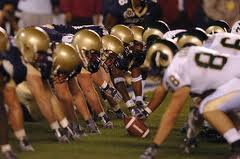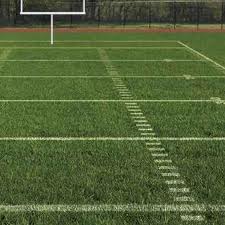AMERICAN FOOTBALL RULES
Choose Your Topic To Read
American football , which was derived from Rugby, is the most popular sport in America. With its unusual jargon and peculiar rules, it might seem a bit complicated at first, but once you get the hang of it, this is bound to be your Sunday staple when the National Football League (NFL) season starts later this year.
TEAM PLAYERS AND OFFICIALS
Players
A cricket team includes 11 players, along with a leader or captain. Outside of formal format, teams can play with more than eleven-a-side, though no more than 11 players may field.

Substitutes
The objective of the game is to score more points than the opponent with in the time. Points were calculated as long as one of the team controls the ball. The offense team has 4 downs to advance at least 10 yards, and can score points once they reach or near the opposite end of the field called the end zone. If the offense does not advance at least 10 yards during their 4 downs, the defense team regains control of the ball and it called turnover on downs.
On offense, points are scored by advancing the ball into the opponent's end zone for a touchdown or kicking the ball from the playing field through the raised the goal posts in the back of that end zone for a field goal. After scoring a touchdown, the offense is given one additional play from the yard line to attempts to score. These attempts are called points after touchdown and are used to score 1 or 2 points as follows: The offense may attempt a field goal kick which is worth 1 point The offense may attempts to readvance the ball into the opponent's end zone for a two point conversation worth 2 points.
While the opposing team has possession, the defense attempts to prevent the offense from advancing the ball and scoring. If an offensive player loses the ball during play or the ball is caught by a defensive player while still in the air, the defense may attempt to run into the offenses end zone for a touchtone. The defense may also score points by tackling the ball carrier in the offenses own end zone, called a safety.
THE FIELDS
An American Football field is 100 yards long and 160 yards wide. The field is divided into strips by white lines, which are marked every 10 yards. The '50 yard line' runs down the middle of the field, and indicates that there is 50 yards of ground between the line and each end zone. The areas at each end of the field which begin with the 'zero-line' are called the 'end zones'. When a player successfully touches the ball down in the end zone of the opposing team, he scores a touchdown for his team.

Match Procedure
Each team has eleven players on the field at any one time, although football teams can have as many as 50 players. Specialized offensive, defensive and specialist players are employed by each team, and are brought onto the field for a particular play. the referee tosses a coin to determine which team will be given the choice of taking first possession of the ball or choosing which end of the field will be their end-zone for the first half. It is unusual for a team not to choose first possession of the ball. After half-time, the team which lost the toss will be given possession of the ball. At the end of the first and third quarters, the teams switch ends to equalise any advantages or disadvantages associated with either end of the field. Each team is entitled to three 'time-outs' for every half. During a time-out, team mates discuss their strategy for their next plays. Game last for 1 hour, and this time is divided up into four fifteen minute quarters. Players should be ready to begin the next play within forty seconds of the end of the last one.
GAME OFFICIALS
The Umpire
Primarily responsible for spotting the ball at the beginning of plays.
The Head Lines man
Responsible for the chains used to verify how many yards a team has covered during a play. He is also responsible for counting how many downs a team has used, and how many they have left.
The Line Judge
Responsible for time keeping and helping the Linesman to set up the line of scrimmage.
The Back Judge
Responsible for monitoring the duration of time outs and half-time.
The Field Judge
Tends to stand towards the rear of the field and makes sure players are in-bounds.
The Side Judge
Also responsible for ensuring players remain in-bounds and supervising play on his side of the field.
Players and Coin Toss
PLAYERS
The NFL tem are permitted 53 players. The most important player on a football team is arguably the Quarterback. The Quarterback is responsible for leading other players on the field. It is usually the Quarterback who hands off the ball to the Receivers or Running Back, who then run or pass to advance the ball. It is the task of the offensive linemen to block for the Quarterback and Running Backs that is to protect the defensive player from opposing players. The Left and Right Guards who stand on either side of him, the Tackles, and, finally, the Receivers, who stand on the furthermost point of each end of the line. The Place-kicker whose main function is to take kick-offs, including kicking the ball to the other team after a field goal or touchdown. The Place-kicker is also likely to be skilled at kicking field goals. The Punter is also used to kick the ball in the event that a team is on its fourth down and it seems unlikely that they will be able to progress further.
COIN TOSS
Three minutes before the start of the game, the referee meets with captains from both teams for a coin toss. The winner of the toss may defer their choice to the start of the second half or they take choice off:
- Receiving the kickoff to start the games or kicking off to start the games.
- Choosing an end of the field to defend in the first quarter.
The loser of the toss gets the remaining option. If a game goes to overtime, a coin toss is held before the start of overtime, but tosses are not held before the start of subsequent overtime periods b. The coin toss may be held between the captains or coaches earlier before the start of the game. At three minutes before kickoff, the captains meet for a simulated coin toss, where the referee announces the results of the earlier toss.
Downs
Downs, or plays, are the cornerstone of American Football. To put it at its simplest, the offensive team has four plays in which to advance ten yards. Plays usually end when a player is tackled or falls and is declared to be 'down'. A player is down as soon as a part of his body other than his hand or foot touches the ground. A player carrying the ball (the runner) is downed when any of the following occurs. Any part of the runner other than his hands or feet touches the ground. Ankles and wrists count as downed. This may because of :
- Contact by an opponent where the opponent tackles the runner by pushing him, grasping him and pulling him to the ground, sliding into his legs, or touching him in any manner prior to any part of the runner other than his hands or feet touching the ground. Unlike the use of the word tackle in other sports, if the opposing player fails to down the ball carrier, it is merely an attempted tackle. If the ball carrier falls onto another player but he doesn't make contact with the ground, he can still get up and keep playing. A player on the ground is not considered part of the ground.
- Intentionally downing the ball: This slide is interpreted as intentionally downing the ball and opponents may then be penalized for hitting him.
- In amateur football, a runner is downed when any part of his body other than his hands or feet touches the ground at any time. In professional football, the runner is not down for such accidental contact; he must be down by contact with an opponent as described above.
The runner goes out of bounds: that is, any part of his body touches the ground or anything other than another player or an official, on or past a sideline or an end line. Note that the sideline itself is out of bounds, so that the runner is deemed out of bounds if he steps on or touches any part of it. Note also that a runner may carry the ball in such a manner that it is over the sideline, so long as the ball or runner does not touch anything out of bounds.
The runner's forward progress toward the opponents' goal line is stopped by contact with an opponent, with little chance to be resumed. The exact moment at which the player's forward progress stops is subject to the judgment of the officials. In particular, for the protection of the quarterback, he is considered down as soon as official judges that he is in the grasp of an opponent behind the line of scrimmage, and the tackling defensive players will be awarded with a sack. If he is driven backward by the opponent, the ball will be spotted where his forward progress was stopped.
PLAYERS POSITION
Center
The player who snaps the ball to the quarterback.
Running Back
Running backs are also referred to as tailbacks, halfbacks and rushers.
Wide Receiver
Teams use as two to four wide receivers on every play.
Tight End
A players who servers as a receiver and also as a blocker. Player lines up besides the offensive tackle to the right or the left of the quarterback.
Left guard and Right guard
The inner two members of the offensive line, whose jobs are to block for and protect the quarterback and ball carriers.
Left Tackle and Right Tackle
The outer two members of the offensive line.
Defensive Tackle
The inner two members of the defensive line, whose jobs are to maintain their position in order to stop a running play or run through a gap in the offensive line to pressure the Quarterback or disrupt the backfield formation.
Defensive End
The outer two members of the defensive line. Their job is to overcome offensive blocking and meet in the backfield where they combine to tackle the quarterback or ball carrier.
Linebackers
These players line up defensive linemen and generally are regarded as the team's best tacklers. Three or four linebackers on every play.
Safety
The players who line up the deepest in the secondary. Free safeties and strong safeties and they must defend the deep pass and the run.
Cornerback
The players who line up on the wide parts of the field generally opposite the offensive receivers.
PENALTIES
Delay of Game
Intentionally wasting time between plays illegal.
Illegal Blocking
There are rules regarding how players can be tackled. A player cannot be tackled from below their knees (fifteen yards) or from behind above their waist (five yards).
Roughing the kicker
Someone who roughs a player or the player who is holding the ball for that player is punished severely. Roughing before play is illegal because the player has not had a chance to re-orient himself and is vulnerable. Encroachment: A penalty committed by defensive players. This involves crossing the line of scrimmage before the snap which begins a play (five yards).
Facemask
Players are not permitted to take hold of the face mask of another play to bring him down. If done intentionally, a fifteen yard penalty is generally incurred.